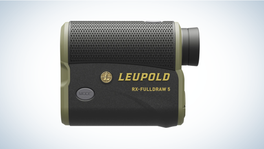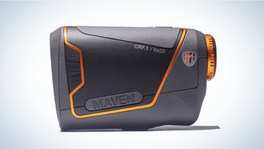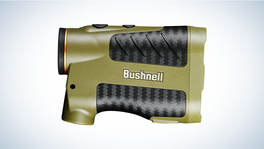We may earn revenue from the products available on this page and participate in affiliate programs. Learn more ›
When reviewing some of the most popular rangefinders for bow hunting, let me start with a little story. Five years ago, in the middle of a Colorado wilderness, I met the best elk hunter you’ve never heard of. The man’s eyes sank back into his head, his face weathered, and his back had an unnatural curve from too many seasons of toting too much weight. Still, there he was, five miles off the trailhead, standing over his 45th bull elk.
He looked at me and said, “Ten years ago, I wouldn’t have killed this bull.” Then, he grinned and pulled an angle-compensating rangefinder from an accessory pouch on his bino harness. “The bull was uphill,” he continued. “I guessed him for 36, and he was only 22. Youngsters need to learn how good they have it. If I had this technology throughout my elk hunting career, I’d have 90 bulls instead of 45.”
I laughed. He was correct about how lucky bowhunters are to have good rangefinders that provide accurate yardage readouts regardless of angle, weather, lighting conditions, etc. As with most gear—like compound bows and bow releases—there are many options in the bowhunting rangefinder arena, and over the years, I’ve used a lot of them. The best bowhunting rangefinders are ones you can depend on to provide you with the proper range so you can send a sharp stick through the lungs of your quarry.
- Best Overall: Leupold RX-FullDraw 5
- Best For Whitetail: Bushnell Broadhead
- Best For Elk: Leica Rangemaster CRF 2400-R
- Best Budget: Maven CRF.1
- Best For Binocular Rangefinding: Zeiss Victory RF 10×42
- Best For Crossbow: Vortex Diamondback HD 2000
- Most Durable: Sig Sauer Kilo3K
How We Picked the Best Rangefinders for Bow Hunting
I have used rangefinders that burn batteries like a truck pulling a trailer burns gas and those that require four or five clicks of the yardage readout button to get a range that proved inaccurate. I have tested those with poor lenses and one in particular that, during a rainstorm, stopped working. I later discovered that the battery compartment lacked a seal, and water filled the inside. Some performed terribly in low light and had lenses as rigid as a pair of gas station sunglasses.
You depend on your bowhunting rangefinder to perform, and I wouldn’t send you into the woods if I hadn’t handled and used each of the to-come models. Some were tested in the whitetail woods, others at 12,000 feet in the Rockies.
The good news: All performed and make a worthy field companion. Here we go.

Best Rangefinders for Bow Hunting: Reviews & Recommendations
Best Overall: Leupold RX-FullDraw 5
Specs
- Magnification: 6-power
- Deer Range: 900 yards
- Features: Archery Angle Compensation
- Weight: 7.5 ounces
- Length: 3.8 inches
Pros
- Flightpath technology
- Red LED readout display
- Rapid range readout
- Climate tested
- Ergonomic
- Waterproof
Cons
- Price
When I drew my coveted bighorn sheep tag, there was no doubt which rangefinder I was taking with me, and when my ram stepped out at a steep downhill angle, the rangefinder read 61.5 yards. I didn’t doubt it for a second.
Not only does the Leupold RX-FullDraw 5 provide right-now yardage readouts, but I also applaud the adjustable red LED brightness settings. The Flightpath technology is a genius addition. After inputting your bow’s fps rating, peep height, and arrow weight, you get exact ballistics that will tell you if your hunting arrow will find obstructions out to 85 yards. That overhanging tree limb is no longer a worry.
The rangefinder has an ergonomic housing, and its size makes it easy to handle. Last Target mode helps the laser cut through moisture to give you an exact yardage readout even in inclement weather, and, like all Leupold RX rangefinders, this beauty is waterproof.

Best For Whitetail: Bushnell Broadhead
Specs
- Magnification: 6-power
- Deer Range: 500 yards
- Features: ARC Modes Regular & Bow
- Weight: 5.9 ounces
- Length: 4.3 inches
Pros
- 50 percent larger objective lens
- +/- 1-degree Angle Range Compensation
- Auto-adjusting black-to-red reticle
- .3-yard distance accuracy out to 150 yards
- Durable
Cons
- Not as compact
- Not a good crossover for the rifle crowd
Like a good scope, a good rangefinder should gather light, and the readout inside should be crystal clear. That’s what you get with the Bushnell Broadhead, and I love the auto-adjusting black-to-red reticle. Bushnell fitted the rangefinder with an ActiveSync Reticle, which analyzes the background and provides a color readout your eye will detect and be able to see instantly. This readout is immediate and it pops into the glass.
Any rangefinder worth its salt will have some form of angle compensation, and the Broadhead does. Bushnell calls it ARC Technology, and it’s as good as advertised. When you’re 20 feet up a hardwood tree and a gagger steps into range, this rangefinder provides the actual horizontal and line of sight distance. This provides the shooter with supreme confidence.
It’s hard to beat the clarity of the fully multi-coated lenses, and colors really pop, which matters when the light is low, and you’re trying to decipher if you’re ranging that buck standing behind a tangle of the brush or the log six yards behind the buck. The rangefinder is priced right and gets the job done.
Best For Elk: Leica Rangemaster CRF 2400-R
Specs
- Magnification: 7-power
- Deer Range: 10 to 2400 yards
- Features: Equivalent Horizontal Range to 874 yards
- Weight: 6.5 ounces
- Length: 4.5 inches
Pros
- Increased magnification
- Light
- Durable
- Weatherproof
- Super clear
- Easy setup and operation
Cons
- Price
Weight matters in the elk woods—especially if you’re hunting in one of the best states to bag a monster elk—and this highly functional handheld unit is light as a feather and tough as a tank. The housing will take a beating and the rangefinder is water and dirt-repellent via the AquaDura coating. The Leica CRF 2400-R will take on any environment and easily handle Mother Nature’s worst moods.
Elk hunters need boosted magnification, and the 7-power optics with integrated diopter compensation are a win. This rangefinder produces the brightest, most clear images I’ve seen in the woods, and automatic brightness control means the LED readout is never too shimmering or dull.
Readouts are immediate, and when elk hunting and a big bull is closing the distance through a maze of pines, you can’t beat the Fast Scan mode, which takes a new measurement every .5 seconds. I hate guessing and I don’t particularly appreciate dropping a rangefinder from my eye to create unnecessary movement because I lose the animal in the lens every time I depress the range button.
Another excellent feature of the rangefinder is it’s a great crossover rangefinder. Many elk hunters bow and rifle hunt, and if you fall into this category, this rangefinder is a solid go-to.
Best Budget: Maven CRF.1
Specs
- Magnification: 6-power
- Deer Range: 650 yards
- Features: LOS/AC Angle Modes
- Weight: 8 ounces
- Length: 4.33 inches
Pros
- Easy setup
- Auto black/red display
- Rapid yardage readouts
- 5-yard minimum range
- Durable
Cons
- Awkward build
- Not a great grip
There are less expensive budget-style rangefinders on the market. Still, when the difference between putting meat on the table and going home with a sob story is often obtaining an accurate distance to the target, I recommend staying away from the extreme budget rangefinders.
When I tested the Maven CRF.1, it provided readouts as close as five yards. When a deer is directly under my stand or a turkey wanders in front of my decoys and close to the blind window, I don’t want to shoot low. Bowhunters often need to shoot their 30- or 40-yard pin at a distance of five yards. Plus, the rangefinder will reach out on reflective objects to 2,400 yards, which makes it a great crossover rangefinder when the bow is put away and the rifle season rolls around.
Yardage readouts are some of the fastest I’ve witnessed, and LOS (line of sight) and AC (angle compensation modes) mean if you’re off target, it was shooter induced. The optics are clear and bright. Though I’m not a fan of the bulky front end and slim back end, the rangefinder fits well into most rangefinder accessory attachment cases and provides proper functionality.

Best For Binocular Rangefinding: Zeiss Victory RF 10×42
Specs
- Magnification: 10-power
- Deer Range: 11 to 2000 yards
- Features: Angle compensation
- Weight: 33.9 ounces
- Length: 6.5 inches
Pros
- Compact and light
- Zeiss T* Coating
- Bluetooth synch with Zeiss Hunting App
- Rapid yardage readout
- Durable
- Weatherproof
- All-in-one system
Cons
- Price
A western bowhunter, I appreciate the value of toting a rangefinding binocular, and you can’t beat the clarity, color, durability, and spot-on exactness of Zeiss’s Victory RF 10×42 rangefinding binoculars. This is the optic for you if you’re a mountain bowhunter who chases mule deer, elk, sheep, goats, and bears.
There is an advantage to having an all-in-one bino/rangefinding system, and that advantage will be found when hunting in vast rugged terrain. Zeiss’ T* Coating produces remarkable images no matter the lighting conditions. With a balanced platform that requires a two-handed operation, you can get on target and acquire an accurate range, even on distant targets, in seconds.
The 10-power magnification makes looking over expansive sections of dirt easy, and the eye relief is second-to-none. Bowhunters don’t need this feature, but it’s great if you hunt with a vertical bow and enjoy taking a high-powered rifle into the high country as well. You can sync your RFs to the Zeiss Hunting App and download personalized ballistics for up to nine rifles or one rifle and various ammunition combinations.
Bonus: The yardage readout button is set in front of the bridge on the right tube, which is an ideal location.

Best For Crossbow: Vortex Diamondback HD 2000
Specs
- Magnification: 7-power
- Deer Range: 1400 yards
- Features: HCD/LOS Modes
- Weight: 7.6 ounces
- Length: 4.1 inches
Pros
- Excellent magnification
- Tripod adaptable
- Durable
- Weatherproof
- Compact
- ArmorTec lens protection
Cons
- Less than par ergonomics
I know many crossbow hunters camp out in ground blinds waiting on game with their bow propped on a set of shooting sticks. For this reason, this tripod-adaptable rangefinder gets the award as the best for crossbow hunters. When you’re in a ground blind, and your horizontal bow is on a set of shooting sticks, you can set up a tripod, loosen the head, and quickly swap from scope to rangefinder without creating in-the-blind movement.
I love the five-yard minimum range. Because most of the best crossbows today sport yardage-calibrated scopes that allow the hunter to reach out, the 7-power magnification, as does the clarity of lenses, comes in handy.
An excellent go-to rangefinder for bowhunters, crossbow goers, and rifle hunters, the Diamondback 2000 is tough as nails. It provides reflective yardage readouts to 2,000 yards and readouts on deer-sized game to 1,400 yards. HCD (Horizontal Component Distance) and LOS modes offer options, and the rangefinder has a lifetime warranty.
Most Durable: Sig Sauer Kilo3K
Specs
- Magnification: 6-power
- Deer Range: 1,500 yards
- Features: Angle compensation
- Weight: 12 ounces
- Length: 4.6 inches
Pros
- Great battery life
- Ultra-durable
- Rapid yardage readout
- Weatherproof
- 5 range modes
- 5 target modes
Cons
- Setup could be easier
Rangefinders take a beating. I have dropped mine down rocky chutes, and several times, after getting a range, dropped the unit and let its cord attachment work. That’s fine, but the rangefinder often smacks a tree or rock as it swings on the attachment cord. I even ran over a rangefinder (accidentally) with my truck at elk camp, and that rangefinder was Sig’s Kilo3K. It didn’t phase it at all.
Aside from being bulletproof, I love the ergonomics and how well the unit balances in my hand. The Kilo3K has five rangefinder modes, including an Archery (ARCH) mode, which is my go-to. Ranges are spot-on, and each time you hit the range button, the laser does its job and an immediate yardage readout pops into the reticle.
The rangefinder has Bluetooth pairing for your ballistic rifle nuts, and you can drop waypoints to the BaseMap app, an advanced digital mapping system. The glass quality is excellent and colors jump to life, and the red OLED display is easily visible. Units can be toggled between yards and meters and HyperScan provides four range updates per second in scan mode.
What to Consider When Choosing a Rangefinder for Bow Hunting
There are some things to consider when looking for a quality rangefinder. First on the list is angle compensation. If you hunt anywhere in the world, you will need angle compensation. Don’t think for a second that you don’t need angle compensation because you stalk pronghorn on the plains or hunt whitetail at close range from a treestand.
Next on the list is the ease of setup. I have handled rangefinders that required a NASA pedigree to operate, and you don’t want that. Rangefinder setup should be simple.
Lastly, you want the rangefinder to be ergonomic and durable and have a rapid yardage return that shows up well in the reticle. That is a red flag if you hit the yardage button and don’t get an immediate return.
FAQs
Q: What rangefinder is the most accurate?
Most rangefinders above $250 will provide an accurate range and allow for angle compensation so the archer knows their true range to the target. Most rangefinders are accurate to within +/- 1 yard to a certain distance; however, as the distance to the target increases, that +/- 1-yard readout may shift to +/- 3 yards or more. Archers need not fret. Get an accurate rangefinder to +/- 1 yard out to 100 yards, and you’re ready.
Q: Should a beginner use a rangefinder?
While developing your instincts and woodsmanship is always a good idea, all archers should use a rangefinder. Archery is a game of inches, and you want to know the exact distance to your target. Your arrow isn’t coming off the string at 2,000 fps. Instead, most hunting arrows are moving at speeds between 270 and 315 fps, which means the drop of the arrow is magnified. During practice sessions, I typically guess the range of my target first and then confirm the distance with a rangefinder.
Q: Do I need a rangefinder for bowhunting?
For bowhunters, the rangefinder is an essential tool. I have bow hunted all over North America and have yet to run into a bowhunter that wasn’t carrying a rangefinder. You can skimp out on some bowhunting gear, but a quality rangefinder is a must-have.
Q: How much does a rangefinder cost?
Most quality rangefinders will fall between $300 and $500, and this price range should be the focus for bowhunters. Rangefinders in this price range will have some form of angle compensation, feature quality glass, reasonable magnification, and provide rapid yardage readouts. There are many budget models you can find for under $200, but most will not have angle compensation, which is a bowhunter’s best friend, and for this reason, I prefer to stay away from rangefinders that are a little too easy on the wallet.
Final Thoughts on the Best Rangefinders for Bow Hunting
- Best Overall: Leupold RX-FullDraw 5
- Best For Whitetail Hunters: Bushnell Broadhead
- Best For Elk Hunters: Leica Rangemaster CRF 2400-R
- Best For The Money: Maven CRF.1
- Best For Mountain Bowhunters: Zeiss Victory RF 10×42
- Best For Crossbow Hunters: Vortex Diamondback HD 2000
- Most Durable: Sig Sauer Kilo3K
My archery gear list in order of importance goes bow, arrow, rangefinder. It’s easier to be precise when you know the exact range of your target. You can have the best sight, rest, and bow stabilizer, but if you don’t know the range to your target, your accuracy will wane significantly when you increase distance during practice sessions. For bowhunters, having an angle-compensating rangefinder—like one of these best rangefinders for bow hunting—should be high on the list of priorities.
Lastly, please don’t carry your rangefinder in your backpack or pocket. You want your rangefinder easily accessible, and with today’s quality bino harnesses and rangefinder attachment pouches, there is no excuse for not having your rangefinder close at hand at all times. Plus, with the rangefinder attached to the pouch and the pouch to the harness, you won’t walk off and leave it on that rotted stump. I’m speaking from experience.
Why Trust Us
For more than 125 years, Field & Stream has been providing readers with honest and authentic coverage of outdoor gear. Our writers and editors eat, sleep, and breathe the outdoors, and that passion comes through in our product reviews. You can count on F&S to keep you up to date on the best new gear. And when we write about a product—whether it’s a bass lure or a backpack—we cover the good and the bad, so you know exactly what to expect before you decide to make a purchase.











